The essence of tactical urbanisim is to undertake short-term, low-risk, high-benefit actions that precipitate positive long-term changes.
By Ryan McGreal
Published May 08, 2013
The City of Hamilton's political leadership has hardly any appetite for what we might call strategic urbanism, i.e. carrying out a plan to revitalize the urban area by transforming its transportation system and land use rules and investing in necessary public infrastructure and services.
That is not to say we don't have plans to do this. Indeed, the city's planning processes since the mid-1990s have been dedicated to the principles of urban revitalization. The problem is that the city almost never executes on those plans.
Into the leadership gap comes tactical urbanism - direct actions that citizens can take without waiting for city leaders. Last week, the Hamilton-Burlington Society of Architects (HBSA) organized a talk on tactical urbanism by Mike Lydon, a principal at The Street Plans Collaborative.
Lydon is the author of Tactical Urbanism and Tactical Urbanism 2, free e-books that articulate how it works.
The talk was invigorating and inspiring, and Lydon was kind enough to share his slides (images in this article are from Lydon's slide show unless otherwise noted). I understand the HBSA plans to post a video of the talk; in the meantime, here is my review.
Lydon repeatedly emphasized the point that the essence of tactical urbanism is to take short-term action that precipitates a long-term change. Indeed, many cities are held back by "analysis paralysis" in which study after study and plan after plan is never put into action. (Sound familiar?)
He cited the main criteria that inform tactical urbanism:
Keeping these values in mind will help to guide tactical urbanists toward the most promising actions.
Using the iterated conversion of New York City's Times Square into an active pedestrian space as an example, Lydon identified four steps of successful tactical urbanism.
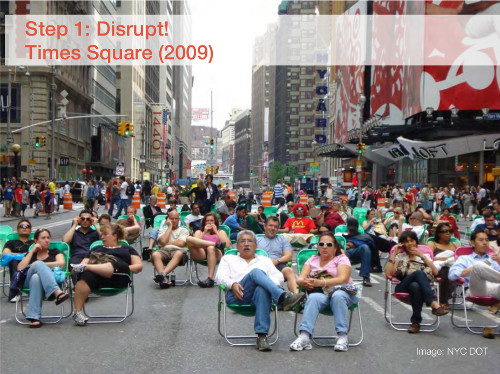
Step 1: Disrupt
The first step was to close the square temporarily and put out deck chairs. This demonstrated an interest in the concept and exposed a wide variety of people to the potential of a pedestrianized square.
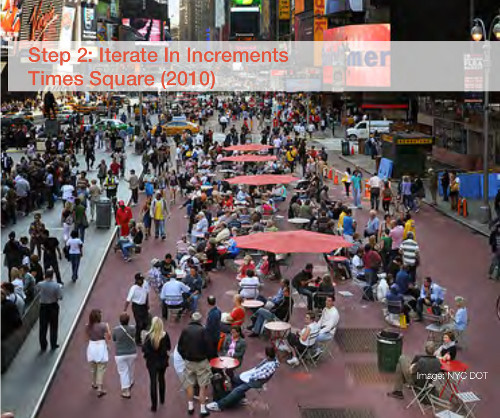
Step 2: Iterate in Increments
In step two, the initial change is tweaked with incremental improvements to improve the experience. Barricades and deck chairs are augmented with painted ground, umbrellas and small tables.
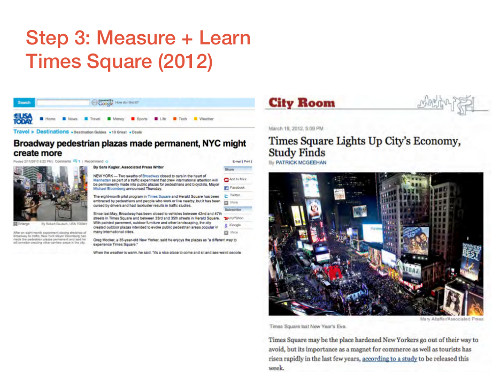
Step 3: Measure and Learn
While experimenting and iterating, observe what works, measure the local impacts, and refine the process.
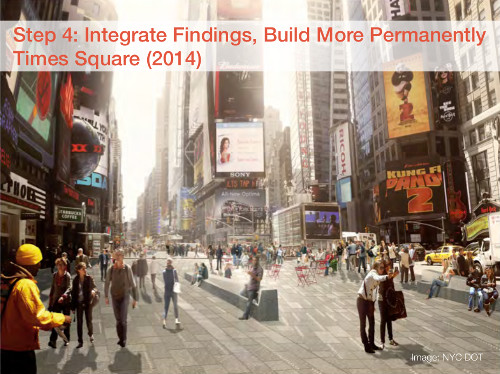
Step 4: Integrate Findings
Finally, integrate the findings and build a permanent change that incorporates the lessons from the iterative process.
Tactical urbanism is a cycle of step-by-step change that feeds back into itself to foster continuous improvement.
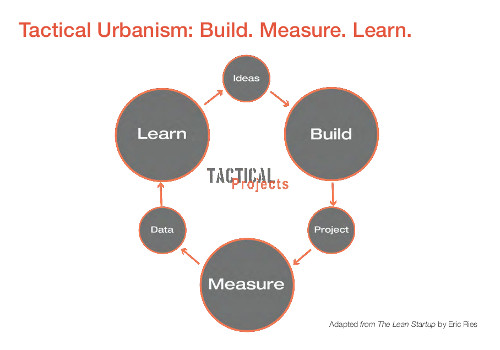
Build, Measure, Learn.
Lydon also stressed that tactical urbanism is not only bottom-up, but also works top-down as leaders recognize the proof of good ideas in action and extend official support to build on them.
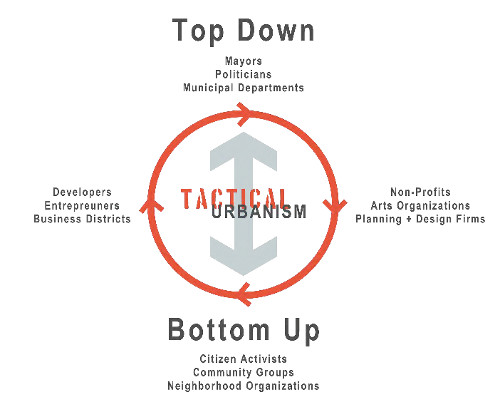
The circle of tactical urbanism (in Hamilton, this is a U-shape)
As such, the actions of tactical urbanism move along a spectrum from bottom-up and unsanctioned to top-down and sanctioned.
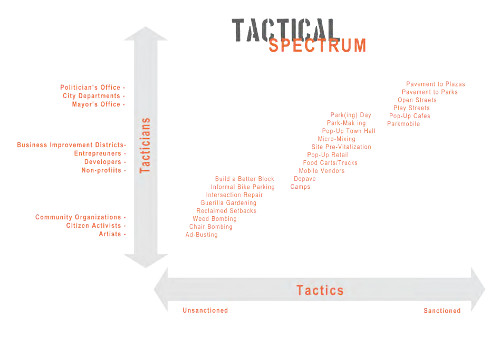
Tactical Spectrum
In recent years, several highly promising tactics have emerged in one city and quickly spread to others, including Intersection Repair, DIY Crosswalks, DIY Bike Lanes, Open Streets, Build a Better Block, Park(ing) Day, Walk [Your City], Pop-Up Retail, Pavement to Plazas, Guerrilla Gardening, Street Seats, Food Trucks, and Future-tising.
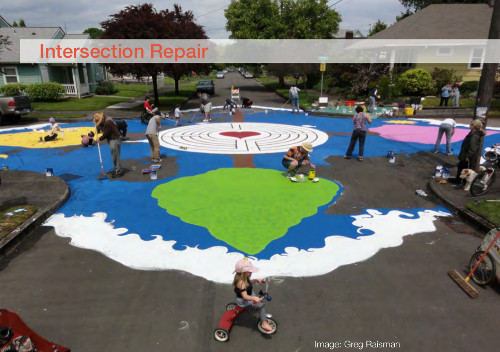
Intersection Repair
Intersection repair is about painting and decorating dangerous intersections to remind drivers that there are people living, working and playing nearby and that they need to slow down to maintain a safe environment.
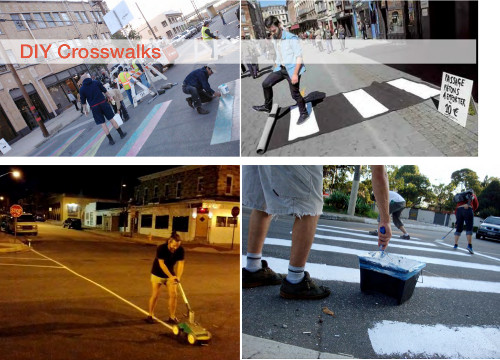
DIY Crosswalks
When the city takes too long to install a crosswalk - or flat-out refuses - residents can paint their own.
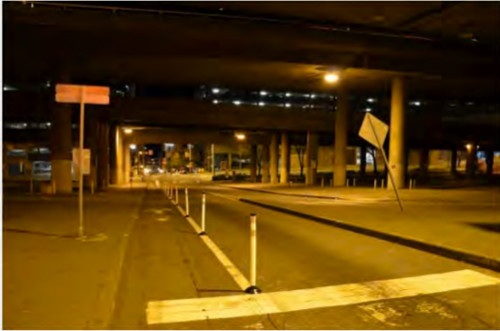
Guerrilla separated bike lanes
A group in Seattle actually installed reflectorized posts along a painted bike lane to provide more visibility and protection for cyclists. In that case, the city had to remove them for safety reasons, but they were very polite about it and agreed that a safer, more permanent separator really would make the lane better.
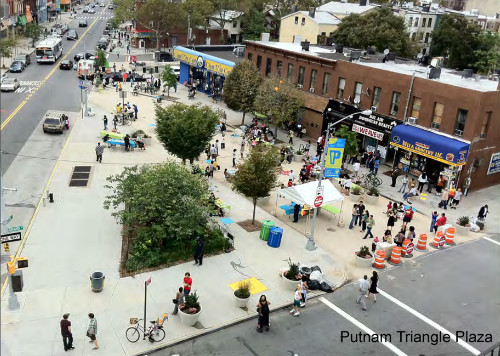
Pavement to Plazas
In cities that evolved incrementally, there are sometimes left-over parcels of land that get allocated to automobiles by default. With creativity and minimal resources, those spaces can be transformed into people places.
As always, early prototypes can demonstrate both a demand for local public space and a measurable benefit, which can then be used to push for a more permanent change.
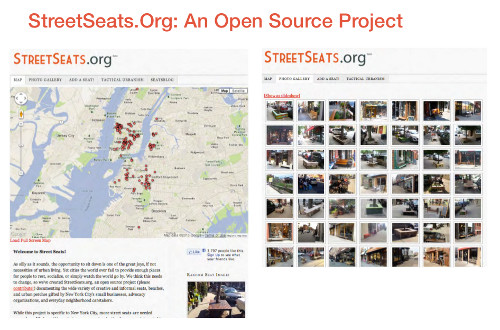
Street Seats
Sometimes taming and humanizing a street can be as simple a matter as giving people a place to sit down.
![Walk [Your City] Walk [Your City]](/static/images/tactical_urbansim_walk_your_city.jpg)
Walk [Your City]
In each case, the important thing is to start with a cheap, low-risk, high-benefit prototype. See what works, tweak the design, measure the effects on the surrounding area, and organize toward a more permanent solution.
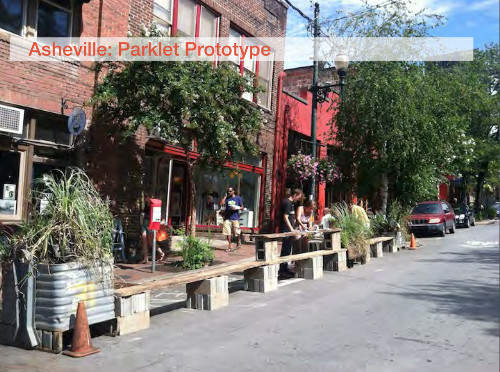
Parklet prototype in Asheville
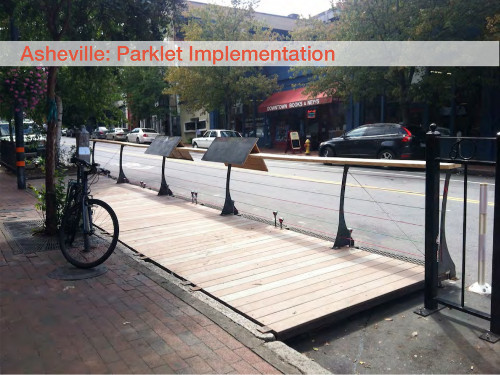
Asheville Parklet implementation
Future-tising creates energy and anticipation for a new project by announcing it. Lydon spoke of a campaign in El Paso, Texas, that announced the return of streetcars to its historic downtown streets - before any such plan existed. The guerrilla billboards advertising the plan generated so much excitement and support that the Texas Department of Transport eventually agreed to fund a new line!
Lydon repeatedly compared tactical urbanism to the lean startup industry: a culture of using innovation, sharing and open source tools to build sustainable businesses by bootstrapping from simple, low-cost initial products.
He made reference to the diffusion of innovation as a model to understand how tactical urbanism can create an initiative that ripples out and becomes more normalized as people experience it and evangelize it to others.
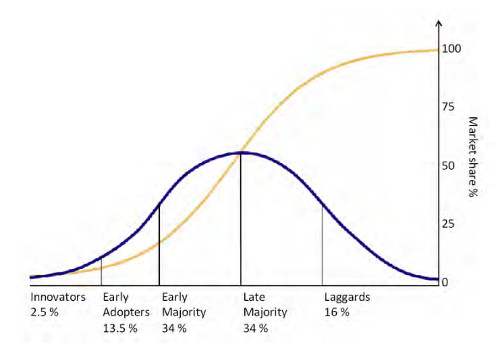
Diffusion of Innovation
He also argued that urban advocates need to understand what he called the continuum of engagement, a bell curve that runs from hostile and angry on one end through bored, neutral and curious and over to engaged and committed on the other end.
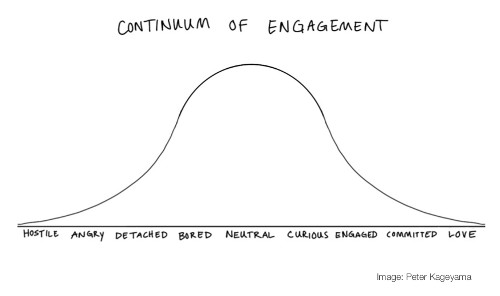
Continuum of Engagement
Looking at Hamilton specifically, Lydon reported on the results of a workshop from two weeks earlier that looked at a few specific spots: The Delta (King and Main), Herkimer and Queen, Upper James and Mohawk, and Cannon and Mary.
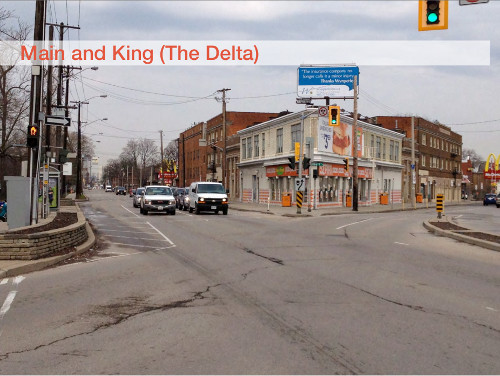
The Delta
The Delta is a pedestrian-unfriendly intersection surrounded by residential and street retail. As a first step, tactical urbanists posted signs on nearby utility polls that read, "I would walk The Delta, but..." and left a space for passersby to leave remarks. (They also launched the hashtag #walkthedelta on twitter).
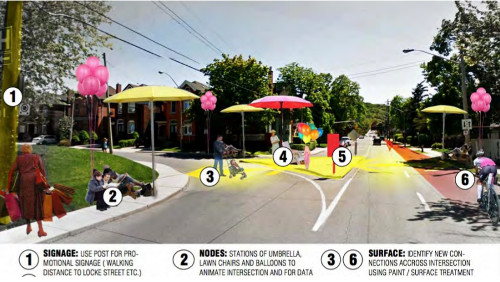
Herkimer and Queen reimagined
At the dismal intersection of Herkimer and Queen, the workshop participants imagined a lively, activated corner with bike lanes, a safe crossing and places for people to congregate.
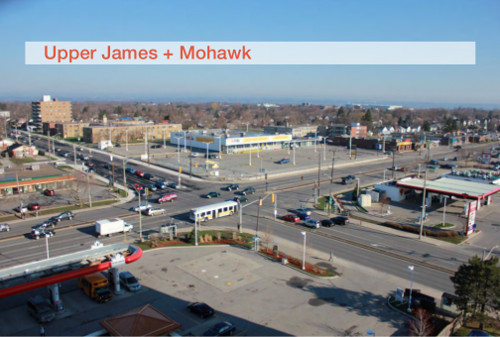
Upper James and Mohawk
Upper James and Mohawk is a particularly bad intersection. There's no sense of place at all, with the nearby retail buildings set far back from the street behind huge parking lots. The workshop participants imagined a radically different corner functioning as a shared space where drivers slow down and various modes intermingle.
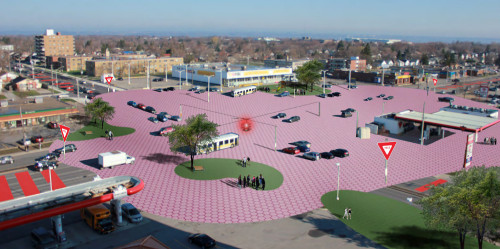
Upper James and Mohawk rendering
A group of activists went to Upper James and Mohawk and staged a friendly demonstration to let drivers know "Upper James and Mohawk is Not Working for Everyone" and to suggest the alternative:
The last corner the workshop considered was Cannon and Mary, the site of the Cannon Knitting Mills and a potential redevelopment.
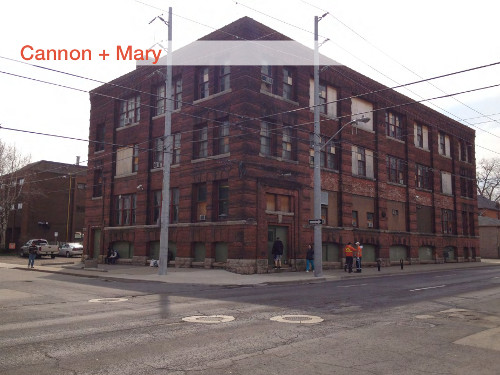
Cannon and Mary
Today, the intersection is held back by Cannon, a four-lane, one-way thoroughfare that is brutally inhospitable to pedestrians and cyclists and just crying out to be made into a complete street.
On Locke and Herkimer, an intersection with St. Joseph's School at the southwest corner, the first act of tactical urbanism is already paying dividends. A group of volunteers placed painted cones at the northeast and southwest corners to 'bump out' the sidewalk, slow traffic, and give pedestrians more space.

Guerrilla Bumpouts at Locke and Herkimer (RTH file photo)
During morning and afternoon rush hours, when large groups of children are crossing, the bumpouts shorten the distance pedestrians have to cross while slowing and taming the automobile traffic.
On Friday I asked the long-time crossing guard what she thought of the project. With immediate enthusiasm, she said, "I like it!" The guard did not know who had installed the cones or why, but she was highly supportive, saying it makes the corner a lot safer.
The traffic calming "really controls the traffic. It was getting scary," she said, noting that the bumpouts force the cars to slow down instead of racing aggressively through the intersection.

Locke/Herkimer crossing guard says guerrilla traffic calming 'really controls the traffic' (RTH file photo)
There are a huge number of opportunities for tactical urbanism in Hamilton: low-risk, high-reward quick wins that don't need to wait for Council approval and can demonstrate their benefits immediately.
If you have any ideas to suggest, post them in the comments!
By movedtohamilton (registered) | Posted May 08, 2013 at 16:58:44
Wow! Fascinating. So much to read and absorb. Have any passersby made comments on the Delta signs?
By Steve (registered) | Posted May 08, 2013 at 19:02:30 in reply to Comment 88437
No idea what people put on signs, but it appears the 2nd Tweet on #walkthedelta wanted longer green lights for cars.
See what you are up against in Hamilton. New hashtag suggestion #upagainst....
By mrgrande (registered) | Posted May 08, 2013 at 17:04:54
There's nothing I'd love to see more than guerrilla bike lanes on Main Street.
By Conrad664 (registered) | Posted May 08, 2013 at 17:15:09
The Delta whould be a nice place to start you have the children musiume and Gage Park
By Rimshot (anonymous) | Posted May 08, 2013 at 17:18:25
"To incremental change, the cause of -- and solution to -- all of Hamilton's problems!"
By Terry Rogers (anonymous) | Posted May 08, 2013 at 19:03:45
I like the bump out at Locke and Herkimer but think that the corner beside Judy Marsales would have been better than the Church corner.
By off-duty at the moment (anonymous) | Posted May 08, 2013 at 22:45:22
"The Delta is a pedestrian-unfriendly intersection surrounded by residential and street retail"
For at least 18 years I crossed through this area regularly(morning noon and night) without a problem and now I patrol it.No real problem.I don't understand yours.
By jason (registered) | Posted May 08, 2013 at 23:12:00 in reply to Comment 88458
based on the number of pedestrians there on a daily basis, I would say you're one of the exceptions. The Delta should bustle and be filled with business and vibrancy like it used to be.
It should feel more like this:
By MLJee (anonymous) | Posted May 09, 2013 at 01:53:57
I live 700 meters from the Gage Park but hate to walk there with my two small children because the traffic is ridiculous-- it comes at your fast and from too many directions at once. Fantastic initiative, TU!
By Eddie (anonymous) | Posted May 08, 2013 at 23:22:52
The pylons look like they limit the mobility of people in scooters and walkers. Future installations should hopefully consider ALL users.
By -Hammer- (registered) | Posted May 09, 2013 at 00:48:44
I don't suppose someone could add
"Or if mischief isn't your cup of tea, and you want to at least try to work with the city you could sign this petition or contact your Councillor or appropriate person at the city if you want to see these changes made."
I'm all for the Cannon and Mary additions as with the Herkimer and Locke ones, but to go out of your own accord and start making changes is just ammo for the city works to continue to not do it's job.
Against the Delta though, I'm one of the majority ( http://www.thespec.com/news-story/221311... ) in the city who feel Main/King St should be left alone. Convert every other street you can to two way, but leave highway 8 alone.
By granny2 (anonymous) | Posted May 12, 2013 at 20:10:15 in reply to Comment 88489
The political and bureaucratic processes respond to and rely on public input, the needs in the community, and ultimately professional design and implementation. Tactical urbanism is temporary implementation as demonstration of what's possible. It's fluid because temporary designs can be changed quickly and easily when issues arise. They are like 'mockups' to see how things will work.
All of that information feeds into the political, bureaucratic and professional processes.
We can show them we are very serious about wanting changes in our neighbourhoods now, and how it works well.
By AlHuizenga (registered) | Posted May 09, 2013 at 11:32:35 in reply to Comment 88489
Nope, start with Main and King. They're the worst offenders with the most volume, and converting them would have the biggest impact, actual and symbolic.
BTW, your read on that Spec article seems a bit selective.
The main take-away from the survey, Ennis says, is that respondents who completely opposed all two-way conversions based their answers on emotions rather than concerns about safety or finances.
It's not about how you feel.
By -Hammer- (registered) | Posted May 09, 2013 at 18:54:49 in reply to Comment 88523
Very well then. I will instead reference successful cities who have major highways/throughfairs through or close to the core of their cities with fast moving traffic and typically cut through the city to reach a highway on the other side, similar in configuration to Main/King and our own Redhill/Linc.
In most cases (although not all) we are looking at least six lanes, almost always divided into three lanes for each type of traffic, with speed limits far higher then King/Main and mostly unsignalized. Now fairly some are on raised parkways with no pedestrian access, but that's not exactly possible given our city's finances.
Now given we can't expand King or Main to six lanes, and a raised parkway is well beyond the city budget, I don't feel a comparison of the close, one way King & Main to these streets is unreasonable, espcially when both ends link continously to Hwy 8.
Portland - Hwy 5 & Hwy 405 (which actualy produce a loop in the core of the city and are fed by the additional Hwy 84 & Hwy 26) & Hwy 205
Seattle - Hwy 5, Hwy 90 and the Alaskan Way Viaduct/Aurora Rd, Hwy 405
Toronto - Don Valley, Gardiner Expr and Hwy 401
San Fransico - Dwight D Eisenhower, The El Camino Real
New York - FDR Drive, Van Wyck, Grand Central, Jackie Robinson, Long Island, Hwy 278 and the list goes on, it's New York, they have every kind of street imaginable.
By ENBertussi (registered) - website | Posted May 09, 2013 at 18:22:43
These super duper awesome renderings are the key to syndicating visionary reformations of urban space for humans.
An army of architect types with the skills and tools needed to create these vivid techno-colour visions of total-awesome-sauce, must be assembled.
This is how you 'visioncast' ideals of an urban place making for all to see and all to embrace, refine, and share with their friends and family.
Just how developers use renderings to sell you a plot on that which was once farm land or a shoebox in the sky, renderings must be used and used again and again and again over and over to put into public view en masse the ideal visions of a walkable, human centred, urban places, that help our culture evolve, beyond that of our; hyper automotive, fossil fuel dependant, urban sprawl, debt slave captivity, mono culture prison.
this is a "PAINT IT AND THEY SHALL SEE" 'visioncasting' reality, then you can build it and they will come, instead of driving by at 70km/hr to go to another global-national-brand-filled mall of crap made in Bangladesh or China made with synthetic materials that are going to lower the life expectancy or quality of life for all animals that inhabit this planet.
ENB..//
By reuben (registered) - website | Posted May 10, 2013 at 09:22:29
With tactical urbanism on my mind, I enjoyed the book titled 'The Visit' that my six-year-old daughter read to me this morning. A great lesson for anyone!
A mouse had a house in a stone wall.
Toad lived down the hill on the other side of the road under a rock.
Mouse and toad were good pals.
Mouse had a white phone. Toad had a red phone. 'Ring-a-ling,' rang Mouse's phone. 'Hello, hello,' she said.
'Hello, Mouse,' said Toad. 'I miss you. I want to go to your house for a visit.'
'Yes, yes,' said the mouse. 'I will make us a pot of tea.' She hung up the phone. She put the teapot on the stove. She set out the cups. She swept the little house.
Toad felt happy. He sang a little tune. 'Off to the mouse house I will hop. I am so happy I cannot stop.
But in between, on the busy road, were cars, trucks, bikes, motor bikes, and even a bus.
All the drivers were speeding past. 'Toot-toot. Hong-honk. Beep-beep.' 'Stop,' said Toad. 'Honk-honk,' went the cars.
Soon Toad began to feel bad. He saw the mouse house across the road. 'When will I ever see Mouse? When will I have a cup of tea?' he asked.
He put a tiny foot into the street. 'Beep-beep,' went the bikes. He jumped back.
Mouse looked out. She saw Toad. She saw the cars. 'Help, help!' yelled Toad. 'I am so unhappy. I cannot get across the road.'
Mouse had to stop and think. 'How will I help Toad?' she asked herself.
All of a sudden she had a good idea. She took white paint and a big red card. On one side she painted 'STOP.'
On the other side she painted 'Toad Crossing.' She went outside with the bold sign. She waved it up and down. She turned it from side to side.
The cars stopped. The trucks stopped. The bikes stopped. The motor bikes stopped. Even the bus stopped.
Toad looked to the left. He looked to the right. No wheels were moving within his sight. He walked across the road and everything was all right.
'Thank you, Mouse,' Toad gratefully said. 'No problem,' said Mouse, as the two went into the house. 'I am always happy to help a toad across the road!'
The End
You must be logged in to comment.
There are no upcoming events right now.
Why not post one?